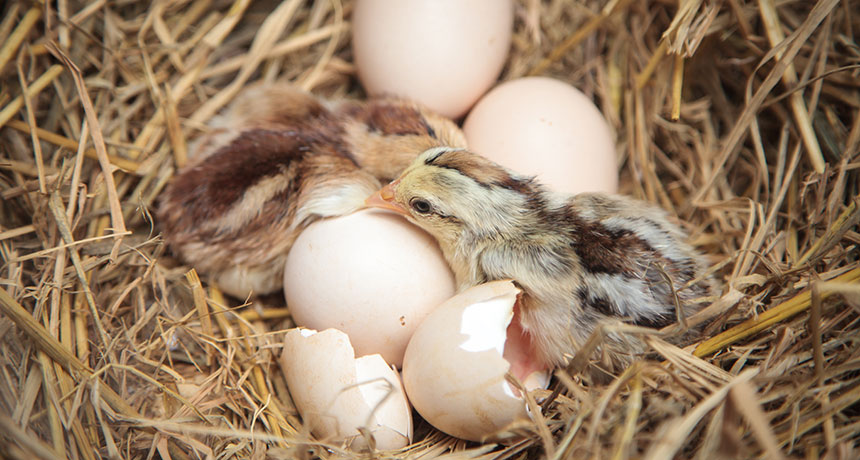Eggshell nanostructure protects a chick and helps it hatch

A chicken eggshell has a tricky job: It must protect a developing chick, but then ultimately let the chick break free. The secret to its success lies in its complex nanostructure — and how that structure changes as the egg incubates.
Chicken eggshells are about 95 percent calcium carbonate by mass. But they also contain hundreds of different kinds of proteins that influence how that calcium carbonate crystalizes. The interaction between the mineral crystals and the proteins yields an eggshell that’s initially crack-resistant, while making nanoscale adjustments over time that ultimately let a chick peck its way out, researchers report online March 30 in Science Advances.
Researchers used a beam of ions to cut thin cross sections in chicken eggshells. They then analyzed the shells with electron microscopy and other high-resolution imaging techniques. The team found that proteins disrupt the crystallization of calcium carbonate, so that what seems at low resolution to be neatly aligned crystals is actually a more fragmented jumble. This misalignment can make materials more resilient: Instead of spreading unimpeded, a crack must zig and zag through scrambled crystals.
Lab tests back up that finding: The researchers added a key shell-building protein called osteopontin to calcium carbonate to yield crystals like those seen in the eggshells. The presence of that protein makes calcium carbonate crystals form in a nanostructured pattern, rather than smooth and even crystal, study coauthor Marc McKee, a biomineralization researcher at McGill University in Montreal, and colleagues found.
The team also found structural variation on a minute scale throughout the eggshell, though it’s only about a third of a millimeter thick. Inner layers have less osteopontin, leading to bigger nanostructures. That may make the inner shell less resilient than the outer shell, which makes sense, McKee says. The outer shell needs to be hard enough to protect the chick, while the inner shell nourishes the developing chick.
Over time, the inner layers of the shell dissolve through a chemical reaction, releasing calcium to build a chick’s developing bones. The eggshell undergoes structural changes to facilitate that process, McKee and his colleagues found.
The researchers compared fertilized eggs incubated for 15 days to nonfertilized eggs. Over time, the nanostructures toward the inner shell became smaller in fertilized eggs, but remained the same in the nonfertilized eggs. The change gives the inside of the eggshell a bumpier texture, and by extension, more surface area. That provides more space for that shell-dissolving chemical reaction to take place, the researchers propose. The reaction also thins the shell overall, making it easier for a chick to break through from the inside when it’s time to hatch.
Advances in imaging technology are helping scientists find new details like this even in objects as familiar as a chicken eggshell, says Lara Estroff, a materials scientist at Cornell University who wasn’t part of the research. In connecting the eggshell’s functionality with its fine-grain structure, the new study could provide inspiration for designing new kinds of materials with specific properties.